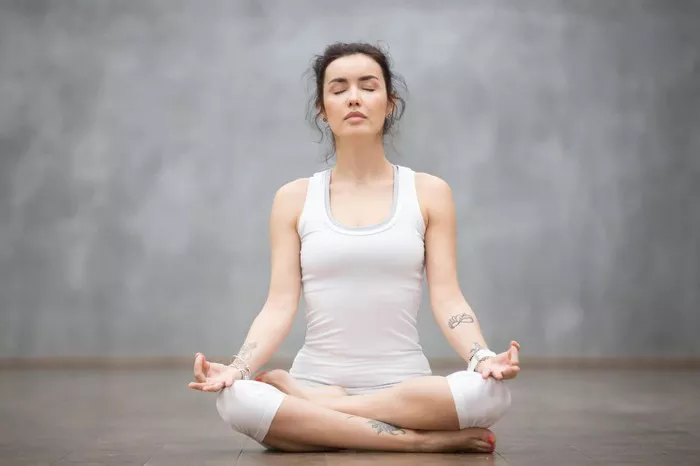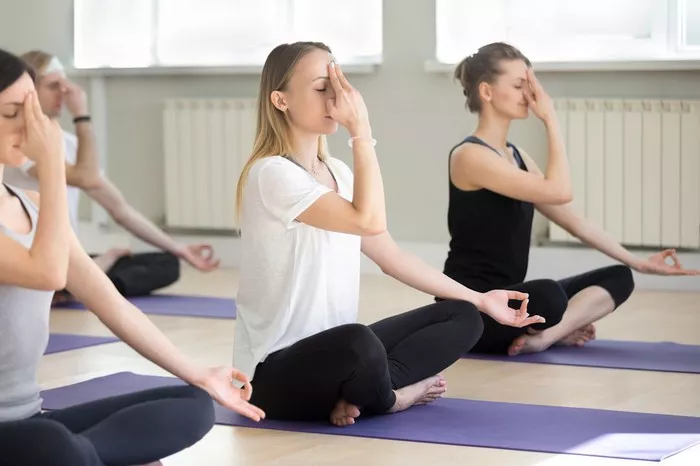Pranayama, derived from the Sanskrit words “prana” (life force) and “yama” (control), is a fundamental aspect of yoga that focuses on regulating the breath. Yogic Breathing Exercises involve conscious control and manipulation of the breath to enhance the flow of prana throughout the body. This age-old practice is deeply rooted in ancient yogic texts like the Yoga Sutras of Patanjali, where it is considered a vital step on the path to self-realization.
The Science Behind Yogic Breathing: A Holistic Approach
Yogic breathing goes beyond the mere act of inhaling and exhaling; it encompasses a holistic approach that involves various components. These include:
1. Deep Diaphragmatic Breathing: At the core of Yogic Breathing is the emphasis on deep diaphragmatic breathing. This technique involves engaging the diaphragm, a dome-shaped muscle separating the chest from the abdomen, to promote fuller and more efficient breaths. This type of breathing stimulates the vagus nerve, initiating the relaxation response and reducing stress levels.
2. Alternate Nostril Breathing (Nadi Shodhana): This pranayama technique involves breathing through one nostril at a time, promoting balance and harmony in the energy channels of the body. Scientifically, this practice has been shown to enhance cognitive function and increase overall brain activity.
3. Ujjayi Breathing: Also known as “ocean breath,” Ujjayi breathing involves constricting the throat slightly during both inhalation and exhalation. This technique not only warms the breath but also has a calming effect on the nervous system. Studies suggest that Ujjayi breathing can enhance oxygenation of the blood and improve lung function.
4. Kapalabhati (Skull Shining Breath): This powerful cleansing breath involves rapid, forceful exhalations through the nostrils, followed by passive inhalations. Kapalabhati helps remove toxins from the body, boosts lung capacity, and invigorates the mind. Research indicates that this technique may have positive effects on respiratory and cardiovascular health.
The Profound Benefits of Yogic Breathing Exercises
1. Stress Reduction and Anxiety Management
In the hustle and bustle of everyday life, stress has become a pervasive issue affecting millions worldwide. Yogic Breathing Exercises offer a natural and effective way to manage stress by activating the parasympathetic nervous system, which induces a state of relaxation and calm. The deep, rhythmic breaths in pranayama techniques signal the body to release tension and reduce the production of stress hormones, providing a sanctuary of peace in the midst of chaos.
2. Improved Respiratory Function
Yogic Breathing Exercises are designed to optimize respiratory function, enhancing lung capacity and promoting efficient oxygen exchange. Deep diaphragmatic breathing ensures that the lower lobes of the lungs, often underutilized in shallow breathing, receive adequate oxygenation. This increased oxygen supply has far-reaching effects on overall health, supporting cellular function, and promoting vitality.
3. Enhanced Mental Clarity and Focus
The connection between breath and mental clarity has been recognized for centuries in various cultures. Yogic Breathing Exercises, such as Nadi Shodhana and Ujjayi breathing, work to balance the flow of energy in the body and clear the mind. Studies have shown that regular practice of pranayama can improve cognitive function, sharpen concentration, and enhance overall mental acuity.
4. Emotional Regulation and Mind-Body Harmony
One of the distinguishing features of Yogic Breathing Exercises is their ability to influence emotional well-being. The controlled and conscious manipulation of the breath helps regulate emotions, fostering a sense of balance and harmony between the mind and body. Practitioners often report increased emotional resilience, reduced reactivity, and a greater capacity to navigate life’s challenges with equanimity.
5. Improved Sleep Quality
In a world plagued by sleep disorders and insomnia, Yogic Breathing Exercises offer a drug-free and holistic solution to improve sleep quality. The relaxation response triggered by pranayama practices helps alleviate tension and induces a state of calm conducive to restful sleep. Incorporating these exercises into a bedtime routine can promote a more peaceful and rejuvenating night’s sleep.
6. Balanced Energy Flow
According to yogic philosophy, prana is the vital life force that flows through the body, influencing physical, mental, and emotional well-being. Yogic Breathing Exercises aim to balance and optimize the flow of prana, ensuring that energy is distributed evenly throughout the body. This balanced energy flow contributes to a sense of vitality, increased stamina, and a harmonious integration of mind and body.
Incorporating Yogic Breathing Into Daily Life
The beauty of Yogic Breathing Exercises lies in their accessibility and adaptability to various lifestyles. Incorporating these practices into daily life does not necessarily require extended periods of time or specialized equipment. Here are some practical tips for integrating Yogic Breathing into your routine:
1. Start with Awareness: Begin by bringing awareness to your breath throughout the day. Take a few moments to observe the natural rhythm of your breath, noticing the inhalations and exhalations without judgment.
2. Set Aside Dedicated Time: Allocate a specific time each day for a more structured pranayama practice. This could be in the morning to energize your day or in the evening to unwind and release tension.
3. Choose Your Technique: Explore different Yogic Breathing techniques to find what resonates best with you. Whether it’s deep diaphragmatic breathing, Nadi Shodhana, Ujjayi, or Kapalabhati, select a technique that aligns with your needs and preferences.
4. Combine with Asanas and Meditation: Integrate Yogic Breathing Exercises into your yoga routine or meditation practice. The synergistic combination of breath, movement, and stillness can amplify the benefits and deepen your overall experience.
5. Be Consistent: Like any wellness practice, consistency is key. Aim to incorporate Yogic Breathing Exercises into your routine regularly to experience the cumulative and transformative effects over time.
Conclusion
In the journey towards holistic well-being, Yogic Breathing Exercises emerge as a beacon of wisdom from ancient traditions. Their profound impact on stress reduction, respiratory function, mental clarity, emotional regulation, sleep quality, and energy flow underscores their relevance in the contemporary world. By embracing the art of conscious breathing, individuals can unlock the door to inner calm, paving the way for a more balanced and harmonious life. As we breathe consciously, we reconnect with the timeless wisdom that reminds us of the intimate link between breath, life, and the pursuit of true well-being.















